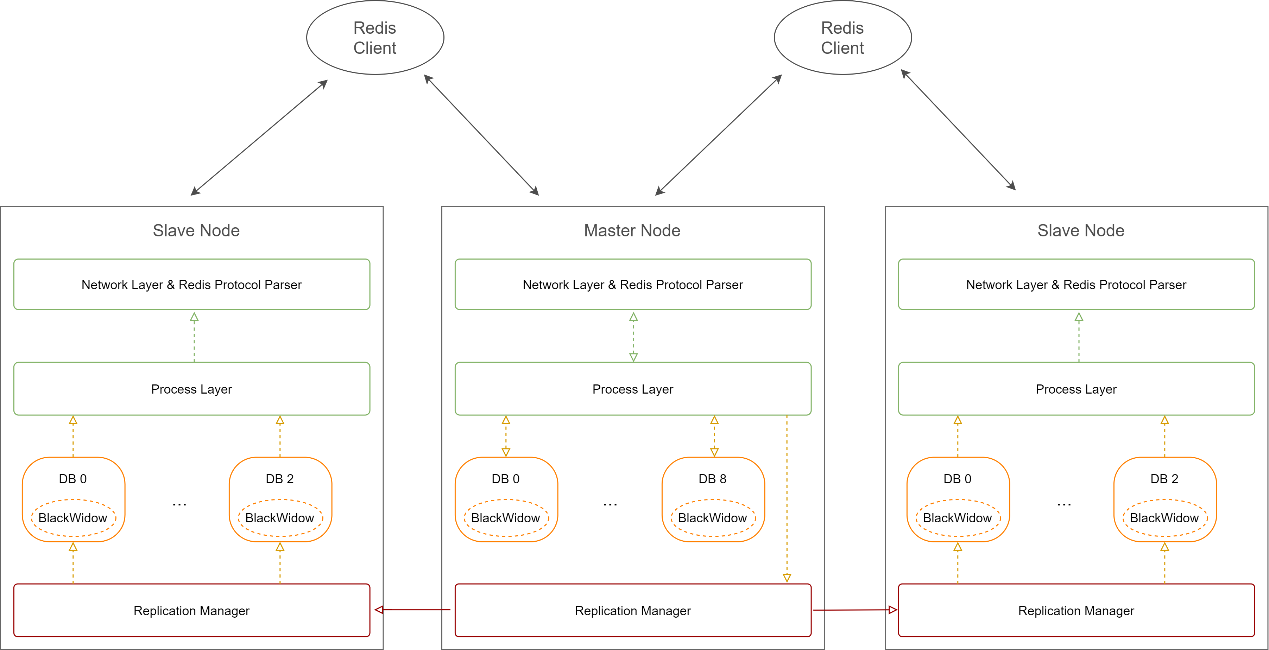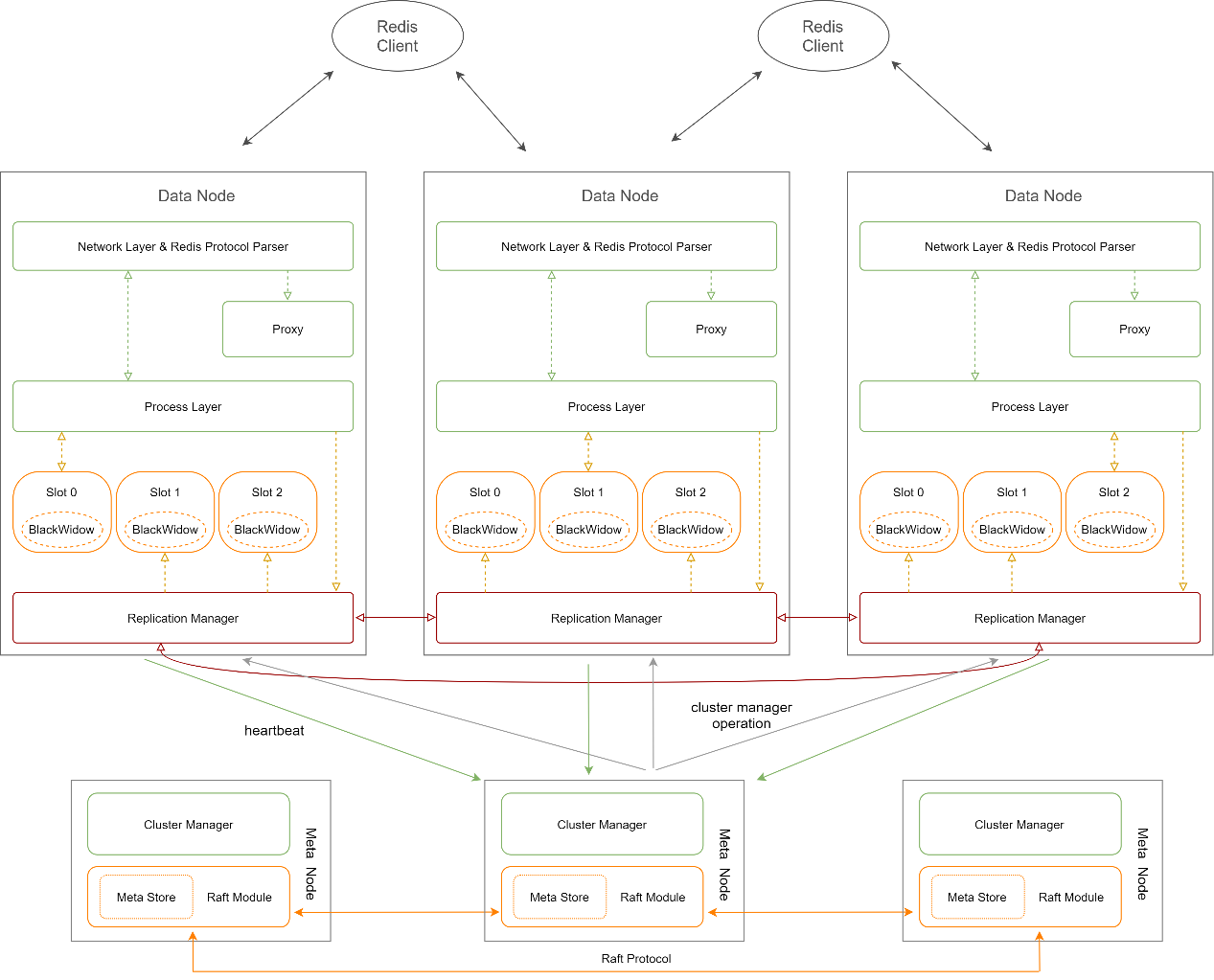 Database
Database
 Redis
Redis
 What is the method of designing the Pika architecture of the Redis storage system?
What is the method of designing the Pika architecture of the Redis storage system?
What is the method of designing the Pika architecture of the Redis storage system?
Pika is an efficient, stable, simple and reliable open source NoSQL database product jointly developed by the 360 infrastructure team and the DBA team. It is fully compatible with the Redis protocol and supports 5 data structures (string, hash, list, set, zset). The data is persisted to RocksDB. Compared with the Redis memory storage method, it can greatly reduce the occupation of server resources and enhance the data security. reliability. It can be deployed in two modes: stand-alone and cluster. The Pika project was launched in 2015 and was subsequently open sourced on Github. It currently has 3,700 stars and 35 contributors. The community has a large number of online businesses using Pika.
Compare Redis
Storage capacity: Redis stores in memory, with high hardware costs and high downtime recovery delays; Pika borrows RocksDB to store to disk, and the amount of data accommodated by a single server is Redis. Dozens of times faster recovery from downtime.
Throughput: Redis QPS is higher, a single server has a million-level QPS; Pika QPS is relatively low, a single server has hundreds of thousands, and Redis is 3 to 5 times that of Pika.
Access latency: Redis should be within 1ms; Pika latency is slightly higher, within 3ms.
Operation and maintenance deployment: Redis supports two methods: stand-alone master-slave and cluster; Pika also supports two methods of deployment.
Applicable scenarios
If the business scenario data volume is relatively large (> 50GB) and the data reliability requirements are high, then Pika can solve your problem.
Scenario 1: Intermediate result storage for large-scale data processing systems
Scenario 2: Business systems using Redis/Redis Cluster for persistent storage
Scenario 3: Large-scale distribution Metadata storage of the traditional system
Architecture design
Pika can choose to run classic mode (Classic) or distributed by setting the instance-mode configuration item in the configuration file to classic and sharding. Sharding of Pika.
Classic mode architecture

- Distributed mode architecture
 ##Distributed mode (Sharding): In Sharding mode, users The stored data set is called a Table. Each Table is divided into multiple shards, and each shard is called a Slot. The data of a certain KEY is calculated by a hash algorithm to determine which Slot it belongs to. Distribute all Slots and their copies to all Pika instances according to a certain strategy. Each Pika instance has a part of the master Slot and a part of the slave Slot. In Sharding mode, Slot is used to divide master and slave, and Pika instances are no longer used. The physical form of slot on Pika is a file directory.
##Distributed mode (Sharding): In Sharding mode, users The stored data set is called a Table. Each Table is divided into multiple shards, and each shard is called a Slot. The data of a certain KEY is calculated by a hash algorithm to determine which Slot it belongs to. Distribute all Slots and their copies to all Pika instances according to a certain strategy. Each Pika instance has a part of the master Slot and a part of the slave Slot. In Sharding mode, Slot is used to divide master and slave, and Pika instances are no longer used. The physical form of slot on Pika is a file directory.
The above is the detailed content of What is the method of designing the Pika architecture of the Redis storage system?. For more information, please follow other related articles on the PHP Chinese website!

Hot AI Tools

Undresser.AI Undress
AI-powered app for creating realistic nude photos

AI Clothes Remover
Online AI tool for removing clothes from photos.

Undress AI Tool
Undress images for free

Clothoff.io
AI clothes remover

Video Face Swap
Swap faces in any video effortlessly with our completely free AI face swap tool!

Hot Article

Hot Tools

Notepad++7.3.1
Easy-to-use and free code editor

SublimeText3 Chinese version
Chinese version, very easy to use

Zend Studio 13.0.1
Powerful PHP integrated development environment

Dreamweaver CS6
Visual web development tools

SublimeText3 Mac version
God-level code editing software (SublimeText3)

Hot Topics
 How to build the redis cluster mode
Apr 10, 2025 pm 10:15 PM
How to build the redis cluster mode
Apr 10, 2025 pm 10:15 PM
Redis cluster mode deploys Redis instances to multiple servers through sharding, improving scalability and availability. The construction steps are as follows: Create odd Redis instances with different ports; Create 3 sentinel instances, monitor Redis instances and failover; configure sentinel configuration files, add monitoring Redis instance information and failover settings; configure Redis instance configuration files, enable cluster mode and specify the cluster information file path; create nodes.conf file, containing information of each Redis instance; start the cluster, execute the create command to create a cluster and specify the number of replicas; log in to the cluster to execute the CLUSTER INFO command to verify the cluster status; make
 How to read redis queue
Apr 10, 2025 pm 10:12 PM
How to read redis queue
Apr 10, 2025 pm 10:12 PM
To read a queue from Redis, you need to get the queue name, read the elements using the LPOP command, and process the empty queue. The specific steps are as follows: Get the queue name: name it with the prefix of "queue:" such as "queue:my-queue". Use the LPOP command: Eject the element from the head of the queue and return its value, such as LPOP queue:my-queue. Processing empty queues: If the queue is empty, LPOP returns nil, and you can check whether the queue exists before reading the element.
 How to clear redis data
Apr 10, 2025 pm 10:06 PM
How to clear redis data
Apr 10, 2025 pm 10:06 PM
How to clear Redis data: Use the FLUSHALL command to clear all key values. Use the FLUSHDB command to clear the key value of the currently selected database. Use SELECT to switch databases, and then use FLUSHDB to clear multiple databases. Use the DEL command to delete a specific key. Use the redis-cli tool to clear the data.
 How to configure Lua script execution time in centos redis
Apr 14, 2025 pm 02:12 PM
How to configure Lua script execution time in centos redis
Apr 14, 2025 pm 02:12 PM
On CentOS systems, you can limit the execution time of Lua scripts by modifying Redis configuration files or using Redis commands to prevent malicious scripts from consuming too much resources. Method 1: Modify the Redis configuration file and locate the Redis configuration file: The Redis configuration file is usually located in /etc/redis/redis.conf. Edit configuration file: Open the configuration file using a text editor (such as vi or nano): sudovi/etc/redis/redis.conf Set the Lua script execution time limit: Add or modify the following lines in the configuration file to set the maximum execution time of the Lua script (unit: milliseconds)
 How to use the redis command line
Apr 10, 2025 pm 10:18 PM
How to use the redis command line
Apr 10, 2025 pm 10:18 PM
Use the Redis command line tool (redis-cli) to manage and operate Redis through the following steps: Connect to the server, specify the address and port. Send commands to the server using the command name and parameters. Use the HELP command to view help information for a specific command. Use the QUIT command to exit the command line tool.
 How to set the redis expiration policy
Apr 10, 2025 pm 10:03 PM
How to set the redis expiration policy
Apr 10, 2025 pm 10:03 PM
There are two types of Redis data expiration strategies: periodic deletion: periodic scan to delete the expired key, which can be set through expired-time-cap-remove-count and expired-time-cap-remove-delay parameters. Lazy Deletion: Check for deletion expired keys only when keys are read or written. They can be set through lazyfree-lazy-eviction, lazyfree-lazy-expire, lazyfree-lazy-user-del parameters.
 How to optimize the performance of debian readdir
Apr 13, 2025 am 08:48 AM
How to optimize the performance of debian readdir
Apr 13, 2025 am 08:48 AM
In Debian systems, readdir system calls are used to read directory contents. If its performance is not good, try the following optimization strategy: Simplify the number of directory files: Split large directories into multiple small directories as much as possible, reducing the number of items processed per readdir call. Enable directory content caching: build a cache mechanism, update the cache regularly or when directory content changes, and reduce frequent calls to readdir. Memory caches (such as Memcached or Redis) or local caches (such as files or databases) can be considered. Adopt efficient data structure: If you implement directory traversal by yourself, select more efficient data structures (such as hash tables instead of linear search) to store and access directory information
 How to implement redis counter
Apr 10, 2025 pm 10:21 PM
How to implement redis counter
Apr 10, 2025 pm 10:21 PM
Redis counter is a mechanism that uses Redis key-value pair storage to implement counting operations, including the following steps: creating counter keys, increasing counts, decreasing counts, resetting counts, and obtaining counts. The advantages of Redis counters include fast speed, high concurrency, durability and simplicity and ease of use. It can be used in scenarios such as user access counting, real-time metric tracking, game scores and rankings, and order processing counting.





